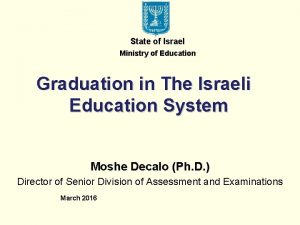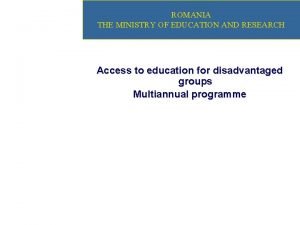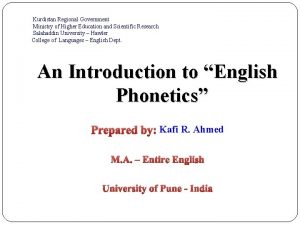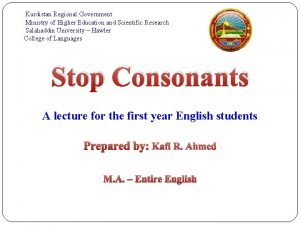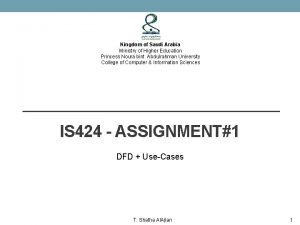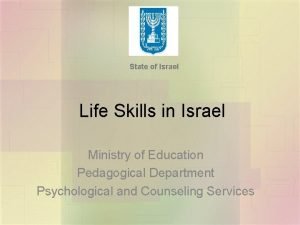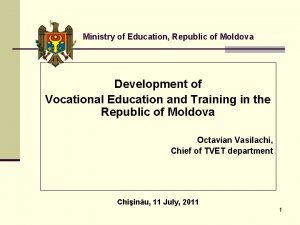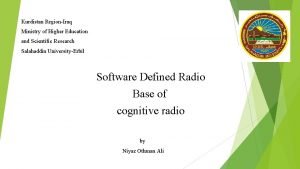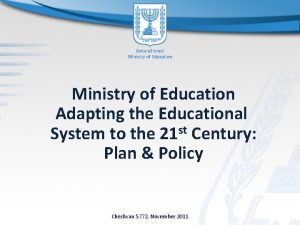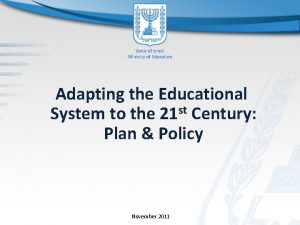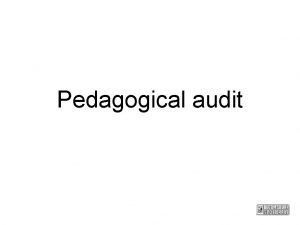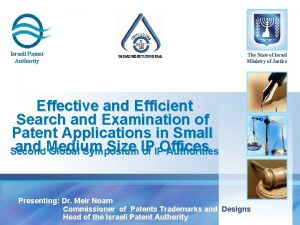State of Israel Ministry of Education The Pedagogical































- Slides: 31

State of Israel Ministry of Education The Pedagogical Secretariat Languages Department Inspectorate for English Language Education T HE N ATIO NAL PRO GR AM TO PRO MOT E E NGL ISH L EAR NING I NTRODUCTORYMEETING Tziona Levi, Phd

English speaking, why?


why?

T HE N ATIONA L PROGRAM TO PROMOTE E NGLISH LEARNING

1. The KEEP TALKING program: principles and instructions 2. Workshops and modeling Lets begin



H OW CAN SPEAKINGFLUENCY BE ACHIEVED?

C ONSIDER How speaking in English happens Characteristics of an English classroom How we can make speaking effective/efficient How can we ensure a safe environment that enables speaking How we can give feedback to our studen on their speaking

Which format? • Is more engaging • Requires immediate feedback • Provides support • Is easier to request support • Encourages learner responsibility • Requires better discipline • Reduces anxiety levels

H OW DOES SLA/FL WORK? Input Feedback Output Interaction

KEEP TALKING…. (: I always yawn when I’m interested.

K EEP T ALKING P ROGRAM A 30 hour speaking course for 10 th graders to provide opportunities to practice and improve speaking abilities as a life skill and in preparation for the Oral Bagrut.

R ESOURCES: -30 hours per homeroom class -25 shekels per student per approved book -National counsellor - Jane Cohen

I MPLEMENTATION: H OURS ● ● ● The hours are additional to those already being taught. The hours are for 3, 4, and 5 pointers in 10 th grade. 30 “hourly rated-effective” hours according to the school’s number of normative (homeroom) classes.

I MPLEMENTATIONS CHEDULING ● ● ● Suggested --- 2 hour lessons for 15 weeks Possibility---- Marathon speaking event for some of the hours Possible division by levels, as opposed to homeroom class, as long as each group receives 30 hours

I MPLEMENTATION T EACHERS ● Preferably given by the school English teachers ● Other possibilities - JH Teachers, New Immigrant Teachers, Students, Native Speakers ● Payment according to school profile

I MPLEMENTATION: B OOKS ● ● ● 3 books by 3 publishers are available Books will be presented in handson workshops Order books only according to the number of students actually participating.

M ONITORING On Jan 1 st budget for the teaching hours and the books was transferred to the Ba’aluyot according to school profile, including 25 shekels per student per book. 2. Be prepared to report: a) Teachers’ details b) Students’ names and ID numbers c) Schedule (dates and hours) 1.

M ONITORING Unused funds due to fewer classes/hours being taught, and books that are not purchased --- will be refunded to the Ministry.

A SSESSMENT (OF SPEAKING) gather ample evidence of student learning answer three basic questions that will help teachers & students make progress: Where am I going? How am I doing? Where to go next? Hattie, J. & Timperley, H. (2007). The power of feedback. Review of Educational Research, 77 (1), 81– 112.

To make assessment more effective and efficient. Feedback from a variety of sources Good models Good rubrics Where am I going? How am I doing? Where to next? Lots of feedback

A CYCLICALAPPROACH: LEARNING AND ASSESSMENT 1. Create user-friendly rubrics. 2. Give your students models of the performance that you expect Model and how to apply your rubric to them. Perform Practice 3. Give them the opportunity to practice applying the rubric. Perform Practice 4. Have them perform. 5. Have them apply the rubrics to their own and their peers Feedback Adapted from Wiggins, G. (1998) performance and provide feedback. 6. Repeat the process.

M ODELING This is an example of intermediate-level performance. Here is where you can see evidence of meeting the criteria Maintains and closes conversations in a culturally appropriate manner most of the time Uses a variety of simple and compound sentences, and some complex sentences Uses a variety of communication strategies as necessary to maintain communication (e. g. circumlocution, paraphrasing, requesting clarification and/or information). Pronunciation and intonation patterns, pacing, and delivery are comprehensible to an audience unaccustomed to interacting with language learners; their pronunciation is consistent, with few errors that do not impede comprehensibility. Is able to ask a variety of simple questions. ✓ ✓ ✓

P RACTICE This is an example of a role play. Identify evidence of the following: Maintains and closes conversations in a culturally appropriate manner most of the time Uses a variety of simple and compound sentences, and some complex sentences Uses a variety of communication strategies as necessary to maintain communication (e. g. circumlocution, paraphrasing, requesting clarification and/or information). Pronunciation and intonation patterns, pacing, and delivery are comprehensible to an audience unaccustomed to interacting with language learners; their pronunciation is consistent, with few errors that do not impede comprehensibility. Is able to ask a variety of simple questions. ✓ ✗ ✓ ✓ ✗

P ERFORM 1. Working with a partner, complete the following information-gap activity and record your interaction. 2. Watch your performance and rate yourself using the attached rubric. 3. Watch two other role-plays and rate your peers using the rubric. Maintains and closes conversations in a culturally appropriate manner most of the time ✓ Uses a variety of simple and compound sentences, and some complex sentences ✗ Uses a variety of communication strategies as necessary to maintain communication (e. g. circumlocution, paraphrasing, requesting clarification and/or information). ✓ Pronunciation and intonation patterns, pacing, and delivery are comprehensible to an audience unaccustomed to interacting with language learners; their pronunciation is consistent, with few errors that do not impede comprehensibility. ✓ Is able to ask a variety of simple questions. ✗

S ELF A SSESSMENT A self-assessment rubric will be available shortly on the ‘Stay up to Date’ website, for students to assess themselves at the beginning and at the end of the 30 hour program.



 Israel ministry of health
Israel ministry of health Ministry of transport israel
Ministry of transport israel Kostanay state pedagogical institute
Kostanay state pedagogical institute Nukus state pedagogical institute
Nukus state pedagogical institute Azerbaijan state pedagogical university
Azerbaijan state pedagogical university Leadership styles in childcare
Leadership styles in childcare Ministry of education serbia
Ministry of education serbia Ministry of education kuwait
Ministry of education kuwait Matriculation certificate
Matriculation certificate Ministry of education romania
Ministry of education romania Ministry of education armenia
Ministry of education armenia Ministry of higher education afghanistan
Ministry of higher education afghanistan تعليم الخاص مبارك الكبير
تعليم الخاص مبارك الكبير Kurdistan
Kurdistan Krg ministry of higher education
Krg ministry of higher education Krg ministry of higher education
Krg ministry of higher education Ministry of higher education saudi arabia
Ministry of higher education saudi arabia Ministry of education iceland
Ministry of education iceland Ministry of education and culture cyprus
Ministry of education and culture cyprus Ministry of education morocco
Ministry of education morocco Ministry of education
Ministry of education Ministry of education
Ministry of education Ministry of education peru
Ministry of education peru Secondary engagement programme
Secondary engagement programme Hellenic ministry of education and religious affairs
Hellenic ministry of education and religious affairs Ministry of education
Ministry of education Ministry of education and research romania
Ministry of education and research romania Ministry of education
Ministry of education Ministry of education and science of the russian federation
Ministry of education and science of the russian federation Ministry of higher education erbil
Ministry of higher education erbil Ministry of national education romania
Ministry of national education romania Ministry of higher education tunisia
Ministry of higher education tunisia








